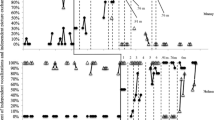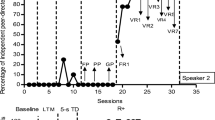Abstract
The purpose of the study was to compare picture exchange (PE) and an iPad™ –based speech generating device (SGD) in teaching mands to five preschool boys diagnosed with autism. Participants’ preferences for each device were assessed following training. Three participants met mastery criterion for mands using the SGD more quickly, while two participants met mastery criterion for mands using PE more readily. However, the overall rate of independent manding across training and maintenance was higher for four participants using the SGD. Four participants demonstrated a clear preference for the SGD device and one for PE. Results are consistent with previous research showing that acquisition of alternative communication modalities varies across children with autism, and supports the use of assessment to determine modality preference.





Similar content being viewed by others
References
Beck, A. R., Stoner, J. B., Bock, S. J., & Parton, T. (2008). Comparison of PECS and VOCA: A replication. Education and Training in Developmental Disabilities, 43, 198–216.
Bock, S. J., Stoner, J. B., Beck, A. R., Hanley, L., & Prochnow, J. (2005). Increasingfunctional communication in non-speaking preschool children: Comparison of PECS and VOCA. Education and Training in Developmental Disabilities, 40, 264–278.
Bondy, A. S., & Frost, L. A. (2001). The picture exchange communication system. Behavior Modification, 25, 725–744.
Charlop-Christy, M., Carpenter, M., Le, L., LeBlanc, L., & Kellet, K. (2002). Using the picture exchange communication system (PECS) with children with autism: Assessment of PECS acquisition, speech, social-communicative behavior, and problem behavior. Journal of Applied Behavior Analysis, 35, 213–231.
Cooper, J. O., Heron, T. E., & Heward, W. L. (2007). Applied behavior analysis (2nd ed.). Upper Saddle River: Pearson.
DeLeon, I. G., & Iwata, B. A. (1996). Evaluation of a multiple-stimulus presentation format for assessing reinforcer preferences. Journal of Applied Behavior Analysis, 29, 519–532.
Durand, V. M. (1999). Functional communication training using assistive devices: Recruiting natural communities of reinforcement. Journal of Applied Behavior Analysis, 32, 247–267.
Flores, M., Musgrove, K., Renner, S., Hinton, V., Strozier, S., Franklin, S., et al. (2012). A comparison of communication using the apple iPad and a picture based system. Augmentative and Alternative Communication, 28, 78–84.
Frost, L. A., & Bondy, A. S. (2002). The picture exchange communication system training manual (2nd ed.). Newark: Pyramid Educational Products.
Goldstein, H. (2002). Communication intervention for children with autism: A review of treatment efficacy. Journal of Autism and Developmental Disorders, 32, 373–396.
Koegel, R. L., & Koegel, L. (2006). Pivotal response treatments for autism: Communication, social, & academic development. Baltimore: Paul H Brookes.
Lancioni, G., O’Reilly, M., Curvo, A., Singh, N., Sigafoos, J., & Didden, R. (2007). PECS and VOCAs to enable students with developmental disabilities to make requests: An overview of the literature. Research in Developmental Disabilities, 28, 468–488.
Lovaas, O. I. (1981). Teaching developmentally disabled children: The ME book. Austin: Pro-Ed.
Lovaas, O. I. (2003). Teaching individuals with developmental delays: Basic intervention techniques. Austin: Pro-Ed.
Maurice, C., Green, G., & Foxx, R. M. (Eds.). (2001). Making a difference: Behavioral intervention for autism. Austin: Pro-Ed.
Mirenda, P. (2003). Toward a functional augmentative and alternative communication for student with autism, manual signs, graphic symbols, and voice output communication aids. Learning, Speech, and Hearing Services in Schools, 34, 203–216.
Peluso, D. (2012). The fast-paced iPad revolution: Can educators stay up to date and relevant about these ubiquitous devices? British Journal of Educational Technology, 43, 125–127.
Rispoli, M. J., Franco, J. H., Van Der Meer, L., Lang, R., & Camargo, S. (2010). The use of speech generating devices in communication interventions for individuals with developmental disabilities: A review of the literature. Developmental Neurorehabilitation, 13, 276–293.
Skinner, B. F. (1957). Verbal behavior. New York: Appleton Century-Crofts.
Son, S. G., Sigafoos, J., O’Reilly, M., & Lancioni, G. E. (2006). Comparing two types of augmentative and alternative communication systems for children with autism. Pediatric Rehabilitation, 9, 389–395.
Sigafoos, J., Doss, S., & Reichel, J. (1989). Developing mand and tact repertoires in persons with severe developmental disabilities using graphic symbols. Research in Developmental Disabilities, 10, 183–200.
Sundberg, M. L. (2007). Verbal-Behavior milestones assessment and placement program. Concord: CA. Achievements in Verbal Behavior.
Weitz, C., Dexter, M., & Moore, J. (1997). AAC and children with developmental disabilities. In S. Glennen & D. DeCoste (Eds.), The handbook of augmentative and alternative communication (pp. 395–431). San Diego: Singular Publishing Group.
Author information
Authors and Affiliations
Corresponding author
Rights and permissions
About this article
Cite this article
Lorah, E.R., Tincani, M., Dodge, J. et al. Evaluating Picture Exchange and the iPad™ as a Speech Generating Device to Teach Communication to Young Children with Autism. J Dev Phys Disabil 25, 637–649 (2013). https://doi.org/10.1007/s10882-013-9337-1
Published:
Issue Date:
DOI: https://doi.org/10.1007/s10882-013-9337-1




